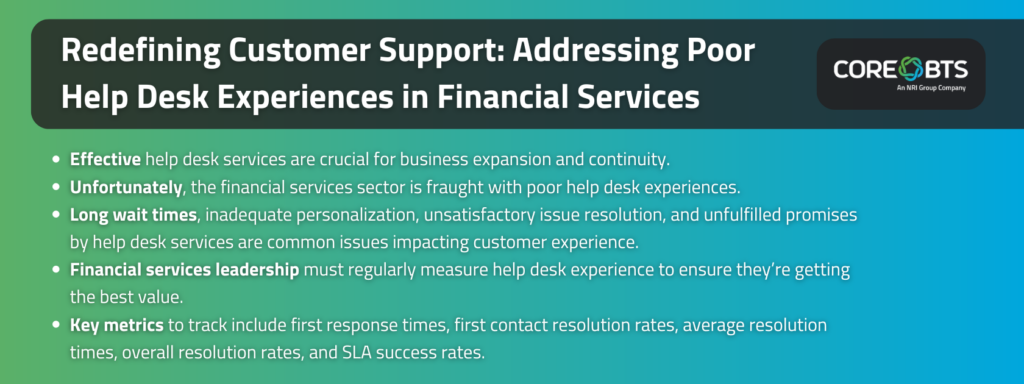Discover common financial services help desk challenges and key metrics you should be tracking to determine if you’re getting a good deal from your provider.

Entrusting the support of modern systems to outsourced help desk services has become increasingly popular among financial institutions looking to drive business growth and stay competitive. In this model, the help desk service provider becomes an extension of your organization, tackling all technical issues while your in-house team focuses on core business functions.
If you’ve outsourced help desk services before, you know that finding the right partner can make or break the experience. This article explores common financial services help desk challenges and key metrics to track which will ensure you’re receiving the greatest value from your help desk partner.
Common Help Desk Challenges Finance Services Organizations Face
Customer experience complaints when dealing with financial services help desks vary widely, but some common themes tend to emerge. They include the following:
Long Wait Times
Picture this: your organization urgently needs assistance with a technical issue, but when you call the help desk services or submit a ticket, it takes hours before someone responds to your query. Frustrating, isn’t it?
Long response times test your patience and lead to lost productivity and efficiency. With a sub-optimal help desk setup, this is a very realistic possibility.
Typically, long wait times occur when help desk services experience an influx of support requests or a significant backlog of tickets. These factors, combined with sup-bar processes and tools, can easily overwhelm help desk resources, leading to delays. That’s why finding a managed services company with advanced capabilities and adequate staffing is crucial.
A closely related problem is difficulty reaching a human agent. It’s always preferable to speak directly to a representative as they can understand issues more clearly. However, this is sometimes hard to achieve given the high reliance on automated phone systems and complex menu options by most help desk services.
Lack of Personalization and Unsatisfactory Issue Resolution
Another common challenge financial organizations face with help desk services is a lack of personalization.
This issue typically results when various help desk representatives handle support requests on different occasions, resulting in an insufficient understanding of the problem, including the context and impact of IT issues. As a result, the representatives may struggle to resolve issues efficiently, leading to disconnect and frustration with the service.
Broken Promises
Finding a help desk partner with the right expertise for your business needs can be daunting. Sometimes help desk services over-promise, but deliver sub-optimal technical support because they lack agents with specialized knowledge of the hardware, software, and network requirements necessary to run your help desk. So, it’s vital to evaluate potential providers’ technical expertise beforehand and measure SLA success rates after bringing them on board.
Measuring key metrics is crucial to understanding and addressing the crisis of poor help desk experiences in financial services organizations.
Help Desk KPIs Financial Services Leadership Should Track
Help desk KPIs track IT support providers’ performance to ensure service levels meet business standards. These are the most relevant metrics financial services leadership should track to determine if their customer experience meets their standards:
First Response Time
The first response time gauges your initial experience when requesting help desk support. It’s how quickly after submitting a ticket or placing a call you connect to a human agent who can promptly resolve the issue you’re facing. For example, when you place a call does a relevant agent respond immediately, or do you have to wait for some time, and if so, for how long?
Typically, financial services leaders measure first response time in minutes, hours, or days with provisions stipulated in their service level agreements (SLAs).
Additionally, there are two approaches to measure the metric; overall first response time across all channels and specific first response times of different channels. Both approaches are useful. While the former tells you how long in general you should expect to get a response, the latter uncovers where to get it more speedily.
First Contact Resolution Rate
The first contact resolution (FCR)rate measures how well help desk services address your needs without you needing to follow up. It’s the percentage of support requests resolved at the first response, whether that’s in-person, or via telephone, live chat, or email.
The higher the FCR rate, the better your team is at resolving issues the first time they arise. You ideally want as smooth an experience as possible, and a high first contact resolution rate helps guarantee that. Additionally, measuring the first contact resolution rate helps determine whether help desk services sufficiently understand your business’s IT challenges and have the relevant expertise and resources to fix them promptly.
Average Resolution Time
Average resolution time is the mean time it takes to resolve a concern after you raise it. It is obtained by dividing the total time spent fixing IT issues by the total number of service requests. This metric gives you an idea of the help desk services’ efficiency.
Individual resolution times may vary depending on the complexity of an issue, and some problems may take longer to resolve. However, if help desk services are consistently slow to resolve issues or don’t properly address them, leading to reopened tickets and high average resolution times, it might be time to have a chat or consider alternatives.
Overall Resolution Rate
The overall resolution rate provides a more holistic view of ticket resolution status by looking beyond issues fixed at the first response. It’s a percentage of all support requests resolved throughout your partnership with the help desk services provider.
SLA Success Rate
The SLA success rate measures the help desk services provider’s compliance with predefined standards. It’s the percentage of issues resolved within the agreed SLA parameters.
Comprehensively measuring the SLA success rate lets you know how well the provider is keeping assurances they’ve made and identifies areas that need improvement. It helps ensure both low and high-priority incidents get attention to prevent any negative impacts on the bottom line.
Better Help Desk Experience With Core BTS
As you focus on delivering the most value for customers, dedicated personal help desk services can give you an edge. That’s where Core BTS comes in.
As a fully-fledged digital transformation consultancy, our experts help the world’s most impactful financial services organizations reshape and elevate the help desk experience to transform from the inside out.
Explore a case study of how Core BTS improved the customer experience of a national bank with top-tier help desk services.





Share on